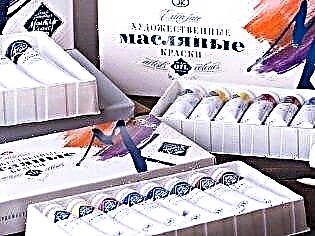
Many novice artists are wondering which paint is best to choose for their work. People who decide to make repairs in the house face the same problem. Often the choice is between oil and acrylic paint. It is difficult for a person who has not encountered them before to decide, because he does not know all the intricacies of working with these paints and varnishes. This article will tell you about the main characteristics, advantages and disadvantages of these types, as well as their differences.

Features of oil products
Oil paints are made on the basis of natural drying oil or its synthetic analogue. A coloring pigment is added to the base and rubbed in a drying oil until a homogeneous base is obtained.
Literally 20-30 years ago, this group of paints and varnishes occupied a leading position in the market. Literally everything, both outside and inside buildings, was painted with oil paints. However, they gradually began to fade into the background. First, they were replaced by nitro enamels, and then by water-dispersed paints.
An artist-painter can work with oil much longer than any other material, because it remains wet for quite a long time.
Before starting work, you must carefully prime the canvas. After the drawing is dry, the paint will not change its color and will not fade.
The layering of oil painting allows you to convey a special depth of the image. Only this kind of art materials helps the artist to apply complex combinations, creating the illusion of reality.

The advantages of this group of paints are obvious.
- Low price category. This factor is very important for many buyers, especially when it comes to processing large areas.
- The product is resistant to moisture. It does a good job of protecting wood, concrete and metal from water. This property allows the paint to be successfully used both outside and inside.
- The convenience of use. Many people doubt whether it is possible to apply a layer of acrylic coating over the old layer of oil and therefore opt for what is already available. This means that many problems with surface preparation for painting will be avoided.
- There are no additional instructions for working with the product. You just need to add a solvent and stir the composition well.
- The consumption of this group of paints and varnishes is much less than that of other products, since it has a high degree of filling.
They have oil paints and a number of disadvantages.
- This type of material is highly toxic. Until the painted surface is dry, it is undesirable to be in the room.
- This group of paints does not have a high coating durability. Layers need to be updated on a regular basis, which takes additional time and expense. Over time, the coating begins to flake off, which also causes damage to the materials to which the paint was applied.
- The color palette is limited.
- The applied paint dries for a very long time (1-2 days).


Features of acrylic compounds
The main components of this group are acrylic composite and water. During the drying process, not only moisture evaporation occurs, but also the polymerization of the components, due to which a coating is formed with high strength.
Acrylic is suitable for working with glass, metal, wood, canvas, linen and other materials that have a non-greasy base. Fresh stains of this type of paint can be easily washed off with plain water. However, if the stain is already dry, you have to resort to using a solvent.
When working with this group of paints and varnishes, remember that the surface to be painted must first be thoroughly cleaned of dirt and dust, as well as degreased. Do not work with these paints at temperatures below 10 °.
Advantages of acrylic paints.
- The products are non-toxic and are considered environmentally friendly. They are practically odorless and do not contain harmful substances in the composition.
- A wide color palette allows you to choose an option for every taste. In addition, you can prepare the shade you need in a special machine.
- Acrylic paints are resistant to ultraviolet light, high humidity and temperature extremes. They can be used for decoration both indoors and outdoors. Also, this group of paints and varnishes has a vapor-permeable coating layer, which excludes the accumulation of moisture in the walls.
- Acrylic coating is durable (it stays in excellent condition twice as long as an oil coating).


- The layers dry very quickly. There are brands, the compositions of which dry in 1 hour.
- The quality and aesthetics of the appearance of the painted surface will satisfy the most demanding buyers. After drying, the layers do not crack.
- The paints are resistant to freezing (freeze at temperatures below -40 °). However, remember that thawing should be gradual, even if it takes several days. This process must not be accelerated with the help of heating devices, hot water, etc. After the paint has thawed, it is necessary to check whether thickened particles have appeared in it, whether it has delaminated. Then you should thoroughly stir the composition and dilute it with water, if necessary.
The disadvantages of this group of paints and varnishes include their high cost. Also, acrylic paints will not allow the artist to work "raw". They cannot convey the full depth of the work, but skillful handling of them allows you to work on a quickly drying layer.
Comparison of two groups of paints and varnishes
The similarities and differences are as follows:
- Acrylic materials are more expensive than oil materials, but they do not have to be renewed every year, spending additional money and time.
- Both groups allow you to perform work both indoors and outdoors. They are resistant to high humidity and protect the material they cover well.
- Unlike acrylic paints, oil paints are highly toxic.
- Oil paints take much longer to dry than acrylic paints.
- The color palette of acrylic is much wider (compared to oil). However, the colors of oil paints after drying are usually brighter and more expressive.


Paints have a completely different composition. The advantage of acrylic paints is that their solvent is water. Even an allergic artist can easily create masterpieces with them. Oil-based paints and varnishes may also be available for artists with allergies, but only if diluted with linseed oil, which is expensive. Most often, such paints are diluted with turpentine, white spirit and other strong-smelling solvents.
Oil paints, in contrast to acrylic paints, are more fluid. Keep this in mind when mixing colors. To obtain a uniform color, the composition must be mixed very thoroughly. This is both a disadvantage and an advantage. If you want “streaks” of different tones to appear on the surface, then mixing should be partial. With acrylic in this sense, everything is much easier. A uniform new color is usually easy to achieve.


Acrylic by oil
It is, in principle, possible to paint the surface with acrylic paint over the old oil layer. But before that, you should make sure that the layer of oil paint is strong enough that no peeling areas are noticeable anywhere. Choose an acrylic paint with a very high level of adhesion that will adhere well to a smooth surface. For example, you can purchase Master-121 acrylic paint for these purposes.


Do not forget to clean the surface of dust, grease, rust and other contaminants before painting.
For information on the best way to write, see the next video.



